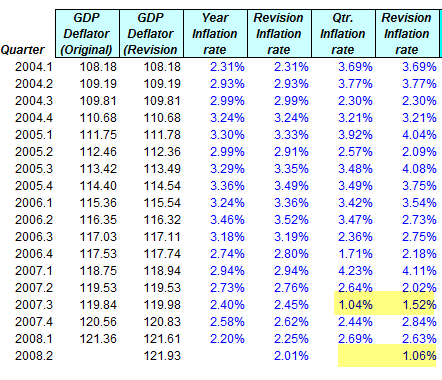The GDP’s inflation metric is clearly bogus
Lately, it seems the U.S. economy is flat on its back, with companies going bankrupt left and right. Yet, government statistics say quite the opposite. In the second quarter, the U.S. economy supposedly grew 1.9% annualized q-o-q. Sounds pretty good, huh?
The sceptic in you might be asking, “how did we manage a 1.9% GDP growth rate in Q2 when the economy looks so awful?”
The answer: bogus data. I’m not one for conspiracy theories, but this data is so obviously false that it galls me to see the U.S. government releasing it.
 What you see above is the GDP deflator series. This is how the U.S. government gets from nominal GDP to the GDP number we all hear on TV. What’s interesting about these numbers is the GDP deflator uses its own inflation gauge , which is entirely different than the CPI. (Update: note, the GDP deflator is altered to take imports out of the GDP statistic. This has the net affect of increasing the GDP deflator when import prices are low and decreasing it when they are high).
What you see above is the GDP deflator series. This is how the U.S. government gets from nominal GDP to the GDP number we all hear on TV. What’s interesting about these numbers is the GDP deflator uses its own inflation gauge , which is entirely different than the CPI. (Update: note, the GDP deflator is altered to take imports out of the GDP statistic. This has the net affect of increasing the GDP deflator when import prices are low and decreasing it when they are high).
Look at the highlighted numbers for Q3 2007 and the last quarter. How is it that inflation was 1.5% in Q3 2007 and 1.1% in Q2 2008? Are they smoking something? Uh, fellas, inflation has been rising, not falling to 1.1%. Hmmm.
Nominal GDP only grew 3.0% in Q2, so Q2’s real GDP number of 1.9% is so obviously false that I expect it to be revised down significantly next year.
Ed,
Just read some of your stuff. Well written. Well reasoned.
One thing you might want to keep in mind is that the changes to the system of measuring CPI have skewed many historical comparisons. For instance, actual housing prices were removed from the CPI starting in 1983 and replace with owners equivalent rent (under Volcker no less). This change allowed much of the money printing by Greenspan to be viewed as wealth creation instead of CPI inflation. Absurd IMO, but definitely something to consider. This was a a significant factor in the moderation of the CPI under Greenspan, especially starting in 1997. Sleight of hand really.
I knew we were in trouble as an economy, when we started viewing housing unaffordability as a positive. I just don’t believe in the free wealth machine. Or the tooth fairy.
Cheers.
Thanks for the input. Back in April I had a post on CPI understating inflation that referenced some of the changes we have seen since the period you’re referencing. John Williams at ShadowStats covers this pretty well.
While I do think the 1980s stats were troublesome in some respects, you’re right in that we don’t have apples to apples data comparisons. It would be nice to see a pro-forma inflation estimate using previous statistical methods.
The same is true for unemployment statistics as well.